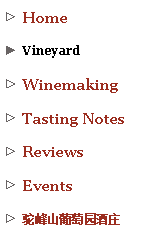

|
Vineyard |
|
The site rises from 180m to 300m, and therefore is well drained. It faces east so receives the early morning sun, invaluable when late season frosts occur. In summer the vines are sheltered from the hot late afternoon western sun by the higher part of the hill. The vines grow in the area's legendary moisture retaining stony red soil derived from volcanic Cambrian rocks, with small pockets of red and black clay and hill wash. Thus, we were able to plant blocks in different soil types and at varying elevations using various clones. The plantings are Shiraz 45%, Cabernet Sauvignon 25%, Merlot 20%; the remainder consists of Viognier, Mourvedre and Petit Verdot; these were chosen because our aim is to produce a Northern and a Southern Rhone style Shiraz and a Bordeaux style Cabernet within an Australian context. The property is 45 hectares with 18 hectares under vine, although not all of this is as yet productive.
At the outset this vineyard was deliberately established on an environmentally sustainable basis so that our vineyard was part of the solution to the issues of climate change and water use, rather than adding to the continuing problem.
It is a dryland vineyard: drip irrigation system has never been installed, therefore, our vines are only watered when it rains. In order to maintain the lightest carbon footprint we use the lightest grade of bottles available which saves on glass, packaging and transport. We use cork closures because they are biodegradable and can be recycled: most importantly, cork enables the wine to build and mature in the bottle.
We do not use treated pine posts which contain copper, chrome and arsenic preservatives, instead, we use sustainably grown native hardwood. We maintain a mulching regime to improve the structure in the soil and mulch all vineyard prunings and grape product from the winery, in the vineyard rows. As a result of this work worms have reappeared in the soil. There is also an extensive population of frogs, ladybirds and other invertebrates and a range of beautiful spiders: desirable predators which keep the vineyard free of pests.
The vines are cane pruned, the best method to obtain the highest quality fruit. We retain the number of buds we think appropriate for each vine with low yields (approximately 1.0 tonne per acre) to provide flavour , complexity and depth. The grapes ripen evenly and in beautiful condition. |


